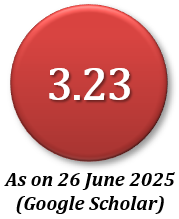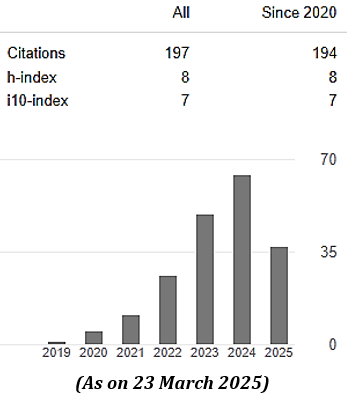Comparative Study of Physical and Mechanical Properties of Machine and Manually Crushed Brick Aggregate Concrete
Abstract
With technological advancement on the rise, manual crushing of bricks is gradually being replaced by machine crushing to obtain coarse aggregates for construction. However, properties of the brick aggregates obtained from these two methods vary which in turn, may affect the properties of the concrete matrix as well. This study represents a comparison between the machine crushed and manually crushed brick aggregates to be used as coarse aggregates in preparation of concrete. Four types of bricks, namely first class, second class, picket (over burnt) and ceramic were investigated, and each was crushed both manually and mechanically to a usable form of aggregates. The physical and mechanical properties of the brick aggregates derived from the two methods were tested and compared. In all types of brick, aggregates size, shape and strength properties such as flakiness and elongation indices, aggregate impact and crushing values and Los Angeles abrasion value showed lower values for manually crushed aggregate indicating better properties compare to machine crushed aggregates. This was evident while comparing compressive and tensile strength of concrete prepared with both manually and machine crushed first class and picket brick aggregates. Concrete with manually crushed brick aggregates showed marginally higher compressive and tensile strength in both types of brick aggregates.
Downloads
References
ACI. (1994). ACI 211.1.91: Standard Practice of Selecting Proportions for Normal, Heavy-weight, and Mass Concrete. Detroit: ACI Committee 211.
ACI. (2014). ACI 318-14: Building Code Requirements for Structural Concrete and Commentary. Detroit: American Concrete Institute.
ACI. (2016). E1-16: Aggregates for Concrete ACI Education Bulletin E1-16. 38800 Country Club Drive, Farmington Hills, MI 48331: ACI Committee E-701.
Adamson, M., Razmjoo, A., & Poursaee, A. (2015). Durability of concrete incorporating crushed brick as coarse aggregate. Construction and Building Materials, 94, 426-432.
Afroz, S., Rahman, F., Iffat, S., & Manzur, T. (2015). Sorptivity and strength characteristics of commonly used concrete mixes of Bangladesh. International Conference on Recent Innovation in Civil Engineering for Sustainable Development (IICSD-2015), Gazipur, Bangladesh.
Akhtaruzzaman, A. A., & Hasnat, A. (1983). Properties of concrete using crushed brick as aggregate. Concrete International, 5(2), 58-63.
ASTM. (2009). ASTM C29/C29M-09 Standard Test Method for Bulk Density (“Unit Weight”) and Voids in Aggregate (2009 ed., Vol. PA 19428-2959). West Conshohocken: ASTM International.
ASTM. (2011a). ASTM C187-11 Standard Test Method for Amount of Water Required for Normal Consistency of Hydraulic Cement Paste (2010 ed., Vol. PA 19428-2959). West Conshohocken: ASTM International.
ASTM. (2011b). ASTM C204-11 Standard Test Methods for Fineness of Hydraulic Cement by Air-Permeability Apparatus (2011 ed., Vol. PA 19428-2959). West Conshohocken: ASTM International.
ASTM. (2011c). ASTM C496/C496M Standard Test Method for Splitting Tensile Strength of Cylindrical Concrete Specimens (2011 ed., Vol. PA 19428-2959). West Conshohocken ASTM International.
ASTM. (2013a). ASTM 109/109M-13 Standard Test Method for Compressive Strength of Hydraulic Cement Mortars (Using 2-in. or [50-mm] Cube Specimens) (2013 ed., Vol. Pennsylvania). West Conshohocken ASTM International.
ASTM. (2013b). ASTM C33-13 Standard Specification for Concrete Aggregates (2013 ed., Vol. PA 19428-2959). West Conshohocken: ASTM International.
ASTM. (2013c). ASTM C191-13 Standard Test Methods for Time of Setting of Hydraulic Cement by Vicat Needle (2013 ed., Vol. PA 19428-2959). West Conshohocken: ASTM International.
ASTM. (2014). ASTM C136/C136M-14 Standard Test Method for Sieve Analysis of Fine and Coarse Aggregates (2014 ed., Vol. PA 19428-2959). West Conshohocken: ASTM International.
ASTM. (2015a). ASTM C39/C39M Standard Test Method for Compressive Strength of Cylindrical Concrete Specimens (2015A ed., Vol. PA 19428-2959). West Conshohocken ASTM International.
ASTM. (2015b). ASTM C127-15 Standard Test Method for Relative Density (Specific Gravity), and Absorption of Coarse Aggregate (Vol. PA 19428-2959). West Conshohocken: ASTM International.
ASTM. (2015c). ASTM C128-15 Standard Test Method for Relative Density (Specific Gravity), and Absorption of Fine Aggregate (Vol. PA 19428-2959). West Conshohocken: ASTM International.
ASTM. (2015d). ASTM C131-15 Standard Test Method for Resistance to Degradation of Small-Size Coarse Aggregate by Abrasion and Impact in the Los Angeles Machine (Vol. PA 19428-2959). West Conshohocken: ASTM International.
ASTM. (2015e). ASTM C150/C150M-15 Standard Specification for Portland Cement (2015 ed., Vol. PA 19428-2959). West Conshohocken ASTM International.
ASTM. (2015f). ASTM C151/C151M-15 Standard Test Method for Autoclave Expansion of Hydraulic Cement (2015 ed., Vol. PA 19428-2959). West Conshohocken ASTM International.
ASTM. (2015g). ASTM C192/C192M Standard Practice for Making and Curing Concrete Test Specimens in the Laboratory (2015 ed., Vol. PA 19428-2959). West Conshohocken ASTM International.
ASTM. (2015h). ASTM C430-08 Standard Test Methods for Fineness of Hydraulic Cement by the 45-μm (No. 325) Sieve (2015 ed., Vol. PA 19428-2959). West Conshohocken: ASTM International.
Ayub, M., Ali, Q., Shahzada, K., Naseer, A., Shoaib, M., & Ayub, U. (2012). Engineering assessment of coarse aggregates used in Peshawar. International Journal of Advanced Structures and Geotechnical Engineering, 1(2), 61-64.
BSI. (1990a). BS 812-105.1: 1989 Testing aggregates — Part 105: Methods for determination of particle shape — Section 105.1 Flakiness index: BSI.
BSI. (1990b). BS 812-105.2: 1990 Testing aggregates — Part 105: Methods for determination of particle shape — Section 105.2 Elongation index of coarse aggregate: BSI.
BSI. (1990c). BS 812-110: 1990 Testing aggregates — Part 110: Methods for determination of aggregate crushing value (ACV): BSI.
BSI. (1990d). BS 812-112: 1990 Testing aggregates — Part 112: Methods for determination of aggregate impact value (AIV): BSI.
Cachim, P. B. (2009). Mechanical properties of brick aggregate concrete. Construction and Building Materials, 23(3), 1292-1297.
fib. (2010). fib Model Code for Concrete Structures: International Federation for Structural Concrete.
Hansen, T. (1992). Recycling of demolished concrete and masonry, RILEM Report 6. Methods. SPON Press, London, UK.
Islam, M. J., Alam, M. R., Islam, M. R., & Hasanuzzaman, M. (2020). Evaluation of Commonly Used Aggregates for Sustainable Infrastructure Development in Bangladesh. International Journal of GEOMATE, 18(66), 98-104. doi: https://doi.org/10.21660/2020.66.9464
Khalaf, F. M., & DeVenny, A. S. (2004). Performance of brick aggregate concrete at high temperatures. Journal of Materials in Civil Engineering, 16(6), 556-565.
Khaloo, A. R. (1994). Properties of concrete using crushed clinker brick as coarse aggregate. Materials Journal, 91(4), 401-407.
Lennon, M. (2005). Recycling construction and demolition wastes: a guide for architects and contractors.
Neville, A. M. (1995). Properties of concrete (4 ed.): Longman Scientific and Technical, London.
Rashid, M. A., Hossain, T., & Islam, M. A. (2009). Properties of higher strength concrete made with crushed brick as coarse aggregate. Journal of Civil Engineering (IEB), 37(1), 43-52.
RMIT University, (2006). Scoping Study to Investigate Measures for Improving the Environmental Sustainability of Building Materials. Department of the Environment, Water, Heritage, and the Arts, Canberra, Australia.
Sahu, G. C., & Jena, J. (2015). Building Materials and Construction (4 ed.): McGraw Hill Education (India) Private Limited.
Yu, J., Cai, X., Ge, Y., & Yu, Y. (2015). Effect of elongated and flaky particles content on the durability of concrete. Fifth International Conference on Transportation Engineering (ICTE), Dailan, China.
MIJST follows the open access policy.

This work is licensed under a Creative Commons Attribution-NonCommercial 4.0 International License. This allows anyone to copy, share, distribute, and modify the work for non-commercial purposes, where the original work and source should be properly credited.
















